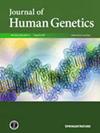多重先天性畸形患者PURA的三重马赛克变异。
IF 2.5
3区 生物学
Q2 GENETICS & HEREDITY
引用次数: 0
摘要
在单基因疾病中,很少发现同一基因的双嵌合变异。在这里,我们报告了PURA(一种神经发育综合征的基因,omim# 616158)的三嵌合变异病例。在我们的病例中,全外显子组测序发现了三个具有类似神经发育综合征的体细胞PURA变体:NM_005859.5: c.222C> a p.(Tyr74*), c.224T> a p.(Leu75Gln)和c.233A>G .(Lys78Arg)。这两种错义变体在相同的序列上,但无义变体却不是。为了确定等位基因的起源,我们进行了长读测序,因为在体细胞变异附近没有信息性的snp。长读测序显示,这三个体细胞变异来自同一染色体。它们发生背后的确切机制尚不清楚,但无义变体可能作为种系事件从头发生,而种系变体的不完全合子后修复可能导致两种错义变体。本文章由计算机程序翻译,如有差异,请以英文原文为准。

Triple mosaic variants of PURA in a patient with multiple congenital anomalies
In monogenic diseases, double mosaic variants of the same gene have rarely been identified. Here, we report the case of triple mosaic variants in PURA, a gene responsible for a neurodevelopmental syndrome (OMIM# 616158). Whole-exome sequencing identified three somatic PURA variants in our case with a similar neurodevelopmental syndrome: NM_005859.5: c.222C>A p.(Tyr74*), c.224T>A p.(Leu75Gln), and c.233A>G p.(Lys78Arg). The two missense variants were on the same sequence read, but the nonsense variant was not. To determine the origin of the alleles, we performed long-read sequencing because of the absence of informative SNPs near the somatic variants. Long-read sequencing revealed that these three somatic variants are derived from the same chromosome. The exact mechanism behind their occurrence is unclear, but the nonsense variant could have occurred de novo as a germline event and incomplete post-zygotic rescue for the germline variant could have led to the two missense variants.
求助全文
通过发布文献求助,成功后即可免费获取论文全文。
去求助
来源期刊

Journal of Human Genetics
生物-遗传学
CiteScore
7.20
自引率
0.00%
发文量
101
审稿时长
4-8 weeks
期刊介绍:
The Journal of Human Genetics is an international journal publishing articles on human genetics, including medical genetics and human genome analysis. It covers all aspects of human genetics, including molecular genetics, clinical genetics, behavioral genetics, immunogenetics, pharmacogenomics, population genetics, functional genomics, epigenetics, genetic counseling and gene therapy.
Articles on the following areas are especially welcome: genetic factors of monogenic and complex disorders, genome-wide association studies, genetic epidemiology, cancer genetics, personal genomics, genotype-phenotype relationships and genome diversity.
 求助内容:
求助内容: 应助结果提醒方式:
应助结果提醒方式:


